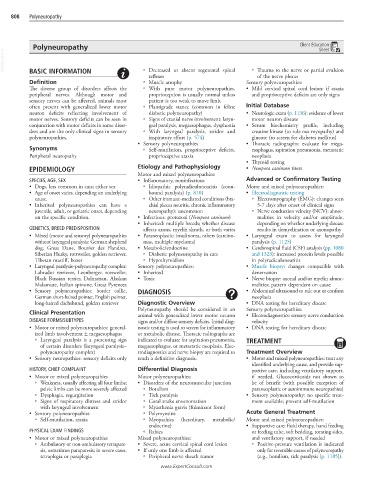Page 1606 - Cote clinical veterinary advisor dogs and cats 4th
P. 1606
808 Polyneuropathy
Polyneuropathy Client Education
Sheet
VetBooks.ir
○ Decreased or absent segmental spinal
BASIC INFORMATION
reflexes ○ Trauma to the nerve or partial avulsion
of the nerve plexus
Definition ○ Muscle atrophy Sensory polyneuropathies:
The diverse group of disorders affects the ○ With pure motor polyneuropathies, • Mild cervical spinal cord lesion: if ataxia
peripheral nerves. Although motor and proprioception is usually normal unless and proprioceptive deficits are only signs
sensory nerves can be affected, animals most patient is too weak to move limb.
often present with generalized lower motor ○ Plantigrade stance (common in feline Initial Database
neuron deficits reflecting involvement of diabetic polyneuropathy) • Neurologic exam (p. 1136): evidence of lower
motor nerves. Sensory deficits can be seen in ○ Signs of cranial nerve involvement: laryn- motor neuron disease
conjunction with motor deficits in some disor- geal paralysis, megaesophagus, dysphonia • Serum biochemistry profile, including
ders and are the only clinical signs in sensory ○ With laryngeal paralysis, stridor and creatine kinase (to rule out myopathy) and
polyneuropathies. inspiratory effort (p. 574) glucose (to screen for diabetes mellitus)
• Sensory polyneuropathies • Thoracic radiographs: evaluate for mega-
Synonyms ○ Self-mutilation, proprioceptive deficits, esophagus, aspiration pneumonia, metastatic
Peripheral neuropathy proprioceptive ataxia neoplasia
• Thyroid testing
EPIDEMIOLOGY Etiology and Pathophysiology • Neospora caninum titers
Motor and mixed polyneuropathies:
SPECIES, AGE, SEX • Inflammatory, noninfectious Advanced or Confirmatory Testing
• Dogs, less common in cats; either sex ○ Idiopathic polyradiculoneuritis (coon- Motor and mixed polyneuropathies:
• Age of onset varies, depending on underlying hound paralysis) (p. 810) • Electrodiagnostic testing
cause. ○ Other immune-mediated conditions (bra- ○ Electromyography (EMG): changes seen
• Inherited polyneuropathies can have a chial plexus neuritis, chronic inflammatory 5-7 days after onset of clinical signs
juvenile, adult, or geriatric onset, depending neuropathy): uncommon ○ Nerve conduction velocity (NCV): abnor-
on the specific condition. • Infectious: protozoal (Neospora caninum) malities in velocity and/or amplitude,
• Inherited: multiple breeds; whether disease depending on whether underlying disease
GENETICS, BREED PREDISPOSITION affects axons, myelin sheath, or both varies results in demyelination or axonopathy
• Mixed (motor and sensory) polyneuropathies • Paraneoplastic: insulinoma, others (carcino- • Laryngeal exam to assess for laryngeal
without laryngeal paralysis: German shepherd mas, multiple myeloma) paralysis (p. 1125)
dog, Great Dane, Bouvier des Flandres, • Metabolic/endocrine • Cerebrospinal fluid (CSF) analysis (pp. 1080
Siberian Husky, rottweiler, golden retriever, ○ Diabetic polyneuropathy in cats and 1323): increased protein levels possible
Tibetan mastiff, boxer ○ Hypothyroidism in polyradiculoneuritis
• Laryngeal paralysis–polyneuropathy complex: Sensory polyneuropathies: • Muscle biopsy: changes compatible with
Labrador retriever, Leonberger, rottweiler, • Inherited denervation
Black Russian terrier, Dalmatian, Alaskan • Toxic • Nerve biopsy: axonal and/or myelin abnor-
Malamute, Italian spinone, Great Pyrenees malities; pattern dependent on cause
• Sensory polyneuropathies: border collie, DIAGNOSIS • Abdominal ultrasound to rule out or confirm
German short-haired pointer, English pointer, neoplasia
long-haired dachshund, golden retriever Diagnostic Overview • DNA testing for hereditary disease
Polyneuropathy should be considered in an Sensory polyneuropathies:
Clinical Presentation animal with generalized lower motor neuron • Electrodiagnostics: sensory nerve conduction
DISEASE FORMS/SUBTYPES signs and/or diffuse sensory deficits. Initial diag- velocity
• Motor or mixed polyneuropathies: general- nostic testing is used to screen for inflammatory • DNA testing for hereditary disease
ized limb involvement ± megaesophagus or metabolic disease. Thoracic radiographs are
○ Laryngeal paralysis is a presenting sign indicated to evaluate for aspiration pneumonia, TREATMENT
of certain disorders (laryngeal paralysis– megaesophagus, or metastatic neoplasia. Elec-
polyneuropathy complex) trodiagnostics and nerve biopsy are required to Treatment Overview
• Sensory neuropathies: sensory deficits only reach a definitive diagnosis. • Motor and mixed polyneuropathies: treat any
identified underlying cause, and provide sup-
HISTORY, CHIEF COMPLAINT Differential Diagnosis portive care, including ventilatory support,
• Motor or mixed polyneuropathies Motor polyneuropathies: if needed. Glucocorticoids not shown to
○ Weakness, usually affecting all four limbs; • Disorders of the neuromuscular junction be of benefit (with possible exception of
pelvic limbs can be more severely affected ○ Botulism paraneoplastic or autoimmune neuropathies)
○ Dysphagia, regurgitation ○ Tick paralysis • Sensory polyneuropathy: no specific treat-
○ Signs of respiratory distress and stridor ○ Coral snake envenomation ment available; prevent self-mutilation
with laryngeal involvement ○ Myasthenia gravis (fulminant form)
• Sensory polyneuropathies ○ Polymyositis Acute General Treatment
○ Self-mutilation, ataxia ○ Myopathies (hereditary, metabolic/ Motor and mixed polyneuropathies:
endocrine) • Supportive care: fluid therapy, hand feeding
PHYSICAL EXAM FINDINGS ○ Rabies or feeding tube, soft bedding, rotating sides,
• Motor or mixed polyneuropathies Mixed polyneuropathies: and ventilatory support, if needed
○ Ambulatory or non-ambulatory tetrapare- • Severe, acute cervical spinal cord lesion ○ Positive-pressure ventilation is indicated
sis, sometimes paraparesis; in severe cases, • If only one limb is affected only for reversible causes of polyneuropathy
tetraplegia or paraplegia ○ Peripheral nerve sheath tumor (e.g., botulism, tick paralysis [p. 1185]).
www.ExpertConsult.com

